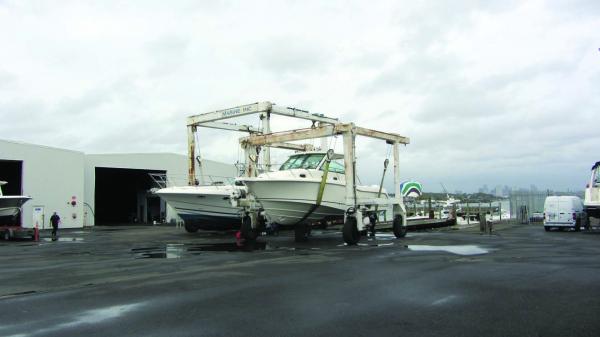October 26, 2017

Port Norfolk’s waterfront would be transformed into a 150-unit condo complex, 25-room hotel and marina under a plan now under review by the BPDA. Neighbors have been sharply critical of the existing proposal. Jennifer Smith photo
Community and environmental groups around Port Norfolk offered the sprawling Neponset Wharf project a chilly reception in public comments that were released by the city’s planning agency this month.
South Boston-based developer City Point Capital is proposing to demolish existing Marine Max/Russo Boston buildings on the peninsula along the Neponset River and Pine Neck Creek and clear out 3.6 acres of land with a connected 4 acres of watersheet used for marina purposes.
The plan for 24 Ericsson St. would install 150 condominium units, a 25-room boutique hotel, covered parking, some commercial space, and renovated boat storage and service facilities. The total area of the wharf proposal, including a boathouse, about two acres of public open space, and three-mixed use buildings, is about 307,000 square feet. The developer is also looking at a total of 185 vehicle parking spaces and 152 bike storage spaces. According to initial filings, vehicle traffic would increase from about 192 trips per day to 1,632 trips per day.
From the start, neighbors noted existing traffic pressures, environmental concerns, and cohesion with the nearby residential area.
“If built as proposed, it would irrevocably change the character of the Port Norfolk community, and would detract from the quality of life,” the Port Norfolk Civic Association wrote in a letter. The civic group described the project as “an accumulation of smaller projects which would individually be rejected out of hand. The combination of forbidden uses, the failure to respect the neighborhood context, and the environmental impact should result in the rejection of any part of the proposal.”
More than 170 pages of public comments submitted to the Boston Planning and Development Agency (BPDA) and available online include about 50 distinct comments, from organizations and individuals alike. A hefty chunk consists of scanned-in pages from a historic review of Dorchester shorelines and the existing Port Norfolk neighborhood plan.
A consistent through-line in the responses is not opposition to development on the underused waterfront site, just concern about this particular plan. Of all the comments submitted, none were outright in favor of the project as presented, and most asked for additional information.
Port Norfolk is a unique location, a small peninsula with the project site accessible through three narrow roads passing through residential blocks. The middle road, Port Norfolk Street, is a one-way route heading toward the waterfront.
“The Port Norfolk neighborhood is already near maximum capacity as it relates to traffic and parking,” wrote Lawley Street resident Jason Berry.
Waterfront groups like the Neponset Greenway Council and the Neponset River Watershed Association asked for a Draft Project Impact Report that would note negative or positive impacts to the local environment, wildlife habitat, wetlands and water resources, and public access.
The Neponset River estuary, several writers noted, is designated as a state “area of critical environmental concern.” Anyone taking on redevelopment on such sites is tasked with improving the water quality, exceeding state standards if possible, not just maintaining current quality. Initial developer filings, according to the Neponset River Watershed Association, “lack sufficient detail to determine whether the project will adequately protect and improve the estuary.”
Other queries on the environmental impact addressed dredging the marina, construction noise disrupting local bird populations, potential marsh destruction if a walking path is built across the creek, and leakage from increased marina use.
Sea level rise and flooding are increasingly concerns for Lawley Street resident Donna Bishop.
“As a member of the Port Norfolk neighborhood in Dorchester for more than twenty years, it is extremely disheartening to me that we are still discussing the monstrous project,” she wrote.
Bishop’s letter noted an ongoing redesign at the nearby, often-flooded Morrissey Boulevard and worried about the strain on water and sewer systems with the addition of 150 new residences and thousands of new visitors to the marina.
The Boston Water and Sewer Commission also weighed in, listing necessary fixes to existing water mains, sewers, and storm drains, as well as a thorough review process needed for any new infrastructure, the cost of which would be City Point Capital’s responsibility.
All of which means a long road ahead for the Neponset Wharf project as it winds its way through the BPDA Article 80 Large Project Review process. The BPDA is reviewing the comment letters and will work with other city departments in scoping sessions, after which the development team would need to submit a Draft Project Impact Report responding to any issues raised by the scoping.
That process then kicks off more meetings with the project Impact Advisory Group, additional community meetings, and further design refinement before any proposal would come before the BPDA board for a vote and the Zoning Board of Appeal for the granting or refusal of any variances.
Even in expressing consternation at the scale of the project, which would, at the least, double the peninsula’s residential population, commenters said they hoped the industrial site would ultimately be improved with the neighborhood’s input.
“I am not opposed to any incoming structure and building at the project site,” wrote Melissa Anderson. “I would like to see the space at the end of the street be more usable for the neighborhood. I believe the proposed structure is too large for the Port Norfolk neighborhood.”


